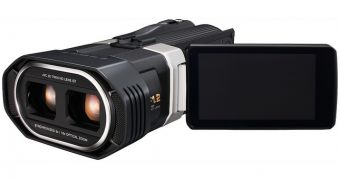JVC joined the select club of mainstream 3D camcorder manufacturers back at CES 2011 and now it's finally starting to ship its JVC GS-TD1 3D imaging device, that will prove to be quite a serious contender on this market.
Before moving forward and talking a bit about the camera's features (especially for those of you who're not familiar with this topic), we'll have to say a few things about the the JVC GS-TD1's pricing, that has recorded quite an interesting evolution ever since the initial announcement.
So, while back at CES 2011, the camera's price point had been set at close to 2,000 US dollars, it seems that JVC's managed to get a grip with reality and noticed the fact that customers wouldn't even go near it, at that huge price point.
For this reason, pricing of the JVC GZ-TD1 Full HD 3D camcorder has been pushed down, to around $1,699.95, which, more or less coincidentally, is roughly the same price point as that of one of its direct competitors, namely the 3D camcorder from Panasonic.
Now, coming back to the actual features and specs of the GZ-TD1, we'll have to mention that it's been equipped with F1.2 JVC 3D Twin HD GT camera lenses and twin 3.32 megapixel CMOS sensors, as well as a brand-new engine capable of processing both left and right images at 1920 x 1080i resolution.
The camera sports 64GB of built-in flash memory (an amount that can be further boosted via the SDXC memory card slot), supports three different movie recording modes (both 3D and 2D), and also offers a 5x optical 3D zoom.
Moreover, it enables users to adjust the 3D – video comfort zone, while also sporting advanced image stabilization systems, particularly needed in the case of a 3D imaging solution.
Last, but certainly not least, we'll also have to point out that it comes equipped with a 3.5-inch glasses-free 3D display, so that users will be able to asses the quality of their 3D video recordings while they're actually recording.
All in all, JVC's device is quite an advanced one, but it remains to be seen just how well it will manage to fare against the solutions already available out there.

 14 DAY TRIAL //
14 DAY TRIAL //